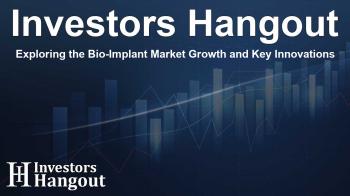Exploring the Bio-Implant Market Growth and Key Innovations

Overview of the Bio-Implant Market
The global bio-implants market is set to experience remarkable growth from USD 146.1 billion to an anticipated valuation of USD 283.7 billion, reflecting a compound annual growth rate (CAGR) of 6.9%. Bio-implants are at the forefront of healthcare innovation, offering advanced solutions that significantly enhance the quality of life for individuals suffering from chronic conditions or disabilities.
Drivers of Bio-Implant Market Growth
The surge in bio-implant adoption is largely attributed to advancements in biotechnology and increasing geriatric populations worldwide. Additionally, the prevalence of degenerative diseases has prompted greater demand for bio-implants. This spike in demand is particularly evident in orthopaedic, cardiovascular, and dental implant sectors, all benefiting from continuous technological improvements in biocompatible materials.
Technological Innovations Shaping the Market
The shift toward personalized medicine between 2025 and 2035 indicates a growing trend in custom bio-implants, reflecting individual patient needs. Moreover, the rapid urbanization and escalating healthcare investments in emerging markets such as India and Brazil are expected to create new opportunities for growth.
Healthcare Investments and Research Initiatives
Governments and private entities are increasing their investments in research and development (R&D), paving the way for groundbreaking advancements in bio-implants, including 3D-printed devices and cutting-edge tissue engineering developments. These innovations are poised to transform treatment protocols and improve patient outcomes.
Types of Bio-Implants
Bio-implants can be categorized into several types, each serving distinct purposes:
- Orthopaedic Implants: Predominantly used for joint replacements and fracture repairs.
- Cardiovascular Implants: Essential tools in managing heart diseases, including stents and heart valves.
- Dental Implants: Used for restoring missing teeth and as anchors for dental prosthetics.
- Spinal Implants: Vital for procedures aimed at stabilizing the spine.
- Ophthalmic Implants: Incorporated into eye surgeries, featuring intraocular lenses.
Regional Insights into the Bio-Implant Market
The bio-implants market is witnessing varying growth trends across different regions.
North America
North America dominates the market due to its advanced healthcare infrastructure and high healthcare spending. The current landscape indicates an upward trajectory in bio-implant sales, driven by extensive consumer awareness and the presence of key industry players.
Asia-Pacific
Contrastingly, the Asia-Pacific region is projected to register the fastest growth during the forecast period. The rising awareness of healthcare solutions coupled with increased investments in healthcare infrastructure plays a pivotal role in this growth.
The Competitive Landscape
Players in the bio-implant industry are forming strategic alliances and collaborations to spur the development of innovative biomaterials tailored for improved performance. The trend towards using human-derived materials for implant production, as opposed to animal sources, is gaining traction. Established companies are also keen on acquiring emerging startups to expand their footprints in untapped markets and diversify their offerings.
Recent Developments
In recent months, notable advancements have been made within the industry:
- CollPlant Biotechnologies has successfully printed breast implants using non-animal-derived collagen bioinks.
- Himed and Lithoz formed a partnership to explore innovative bioceramic feedstocks for advanced 3D printing applications.
- Zimmer Biomet announced the acquisition of OSSIS, enhancing their expertise in personalized 3D-printed implants.
Future Outlook
The bio-implant market's trajectory suggests continued innovation and growth fueled by technological advancements and a favorable regulatory environment. The focus on research and development, alongside increasing healthcare investments, will likely result in new opportunities for stakeholders.
Frequently Asked Questions
What is driving the growth of the bio-implant market?
The growth is driven by technological advancements, a rising elderly population, and increased incidences of chronic diseases.
Which sectors are seeing the highest demand for bio-implants?
The highest demand is seen in orthopaedic, cardiovascular, and dental implant sectors, thanks to ongoing technological innovations.
How do market trends influence bio-implant development?
Increasing emphasis on personalized medicine is reshaping market trends, leading to developments in custom bio-implants tailored to individual patient needs.
What regions are emerging as potential markets for bio-implants?
Emerging markets in Asia-Pacific and Latin America are expected to unlock substantial growth opportunities for bio-implants.
Who are the leading companies in the bio-implant industry?
Industry leaders include Medtronic, Stryker Corporation, Zimmer Biomet, and Abbott, known for their strong research and development capabilities.
About Investors Hangout
Investors Hangout is a leading online stock forum for financial discussion and learning, offering a wide range of free tools and resources. It draws in traders of all levels, who exchange market knowledge, investigate trading tactics, and keep an eye on industry developments in real time. Featuring financial articles, stock message boards, quotes, charts, company profiles, and live news updates. Through cooperative learning and a wealth of informational resources, it helps users from novices creating their first portfolios to experts honing their techniques. Join Investors Hangout today: https://investorshangout.com/
Disclaimer: The content of this article is solely for general informational purposes only; it does not represent legal, financial, or investment advice. Investors Hangout does not offer financial advice; the author is not a licensed financial advisor. Consult a qualified advisor before making any financial or investment decisions based on this article. The author's interpretation of publicly available data shapes the opinions presented here; as a result, they should not be taken as advice to purchase, sell, or hold any securities mentioned or any other investments. The author does not guarantee the accuracy, completeness, or timeliness of any material, providing it "as is." Information and market conditions may change; past performance is not indicative of future outcomes. If any of the material offered here is inaccurate, please contact us for corrections.
